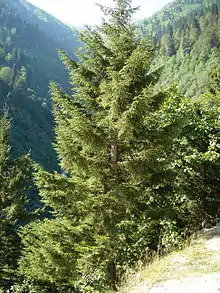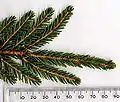Picea orientalis
Picea orientalis, commonly known as the Oriental spruce[2] or Caucasian spruce, is a species of spruce native to the Caucasus and adjacent northeast Turkey.
| Picea orientalis | |
|---|---|
 | |
| Endemique Habitus. | |
| Scientific classification | |
| Kingdom: | Plantae |
| Clade: | Tracheophytes |
| Division: | Pinophyta |
| Class: | Pinopsida |
| Order: | Pinales |
| Family: | Pinaceae |
| Genus: | Picea |
| Species: | P. orientalis |
| Binomial name | |
| Picea orientalis | |
Description
It is a large coniferous evergreen tree growing to 30–45 m tall or 98–145 feet (exceptionally to 57 m), and with a trunk diameter of up to 1.5 m (exceptionally up to 4 m). The Caucasian Spruce can also be found in Northern Iran, though its numbers have decreased due to deforestation.
The shoots are buff-brown and moderately pubescent (hairy). The leaves are needle-like, the shortest of any spruce, 6–8 mm long, rhombic in cross-section, dark green with inconspicuous stomatal lines. The cones are slender cylindric-conic, 5–9 cm long and 1.5 cm broad, red to purple when young, maturing dark brown 5–7 months after pollination, and have stiff, smoothly rounded scales.
It is a popular ornamental tree in large gardens, valued in northern Europe and the USA for its attractive foliage and ability to grow on a wide range of soils. It is also grown to a small extent in forestry for Christmas trees, timber and paper production, though its slower growth compared to Norway spruce reduces its importance outside of its native range. P. orientalis[3] and the cultivar ‘Skylands’[4] have gained the Royal Horticultural Society's Award of Garden Merit.[5] A frequently seen ornamental cultivar is Picea orientalis 'Aureospicata', which has gold-coloured young foliage in the spring.

 Foliage
Foliage Cones
Cones Male cones of var 'aurea'
Male cones of var 'aurea'
References
- Farjon, A. (2013). "Picea orientalis". IUCN Red List of Threatened Species. 2013: e.T42332A2973275. doi:10.2305/IUCN.UK.2013-1.RLTS.T42332A2973275.en.
- "BSBI List 2007". Botanical Society of Britain and Ireland. Archived from the original (xls) on 2015-01-25. Retrieved 2014-10-17.
- "RHS Plant Selector - Picea orientalis". Archived from the original on 21 April 2014. Retrieved 30 June 2013.
- "RHS Plantfinder - Picea orientalis 'Skylands'". Retrieved 25 April 2018.
- "AGM Plants - Ornamental" (PDF). Royal Horticultural Society. July 2017. p. 78. Retrieved 25 April 2018.
External links
| Wikimedia Commons has media related to Picea orientalis. |
- Gymnosperm Database
- Picea orientalis - information, genetic conservation units and related resources. European Forest Genetic Resources Programme (EUFORGEN)
